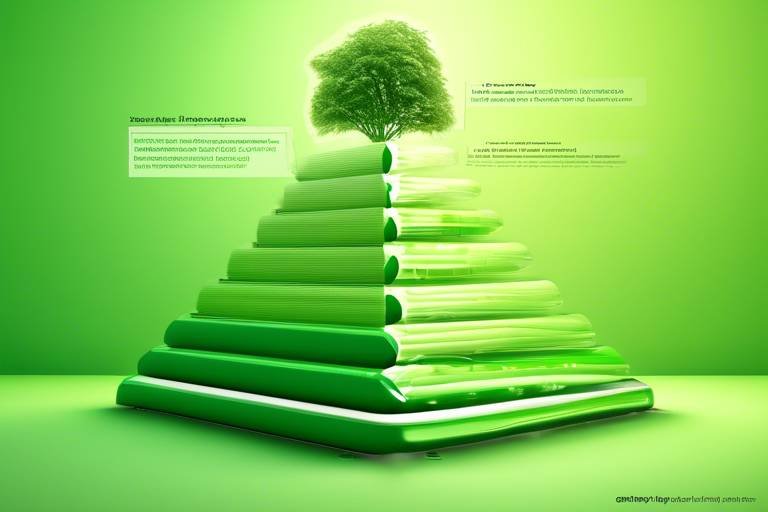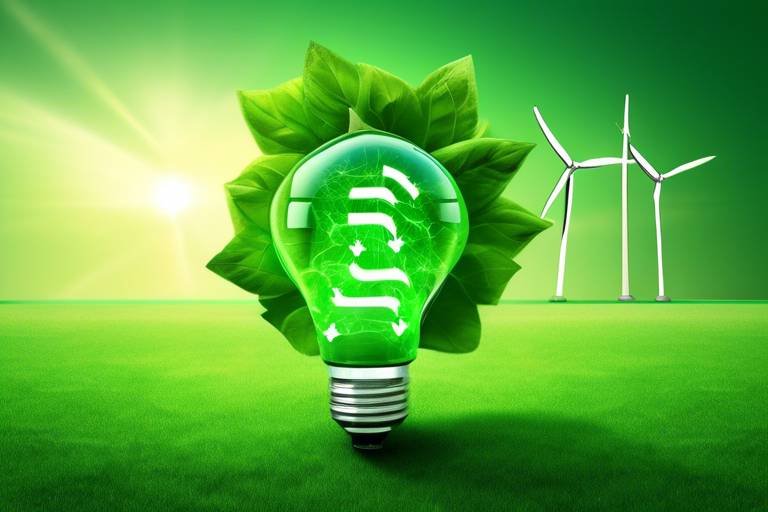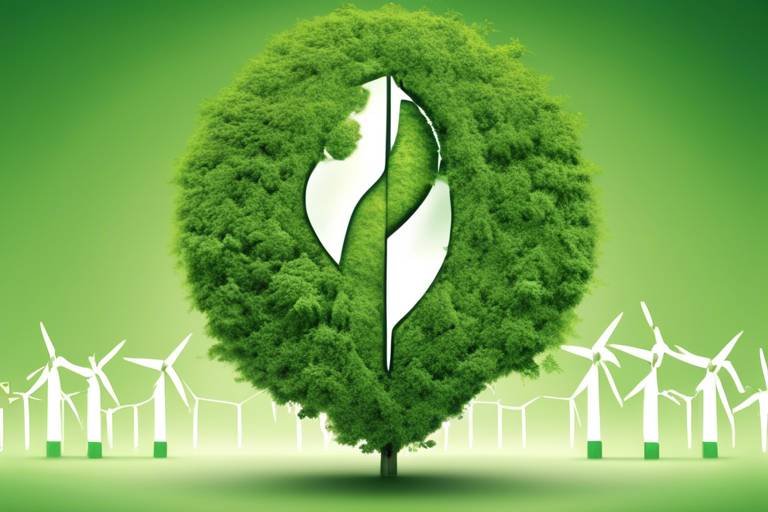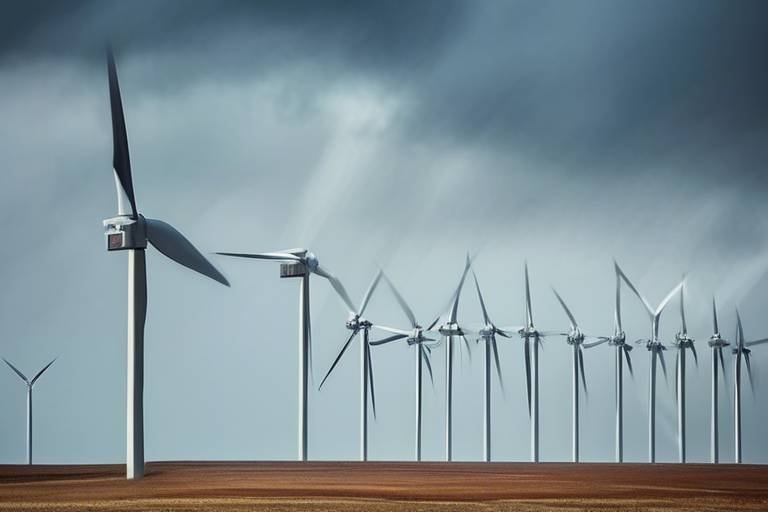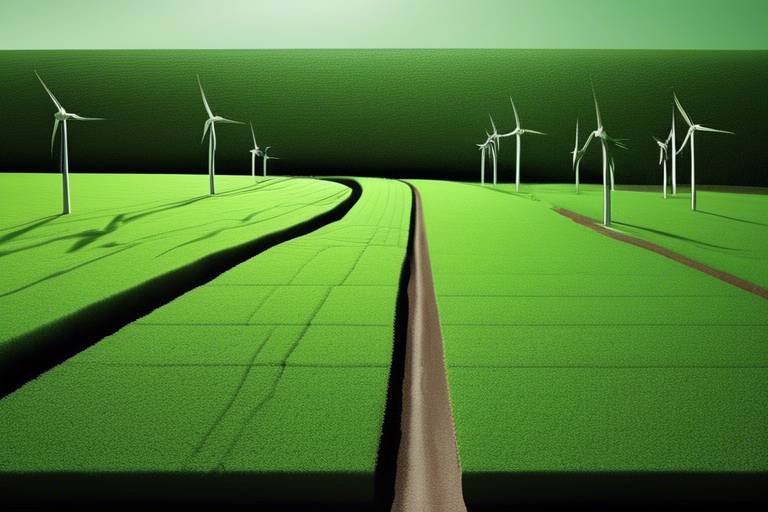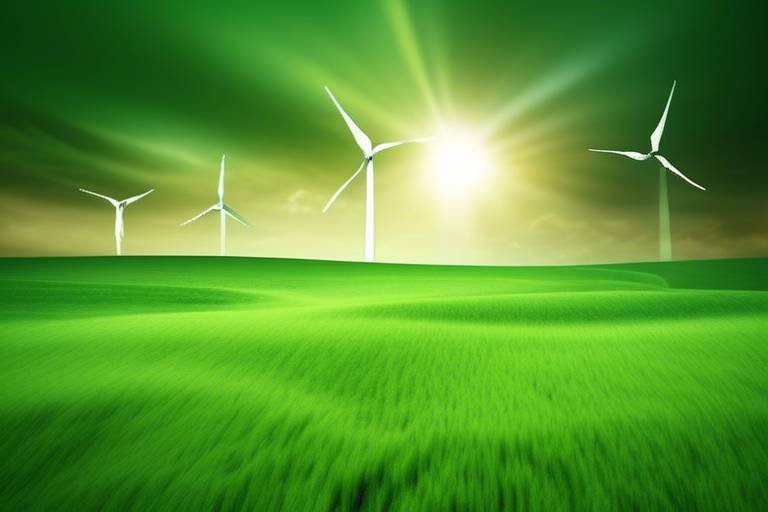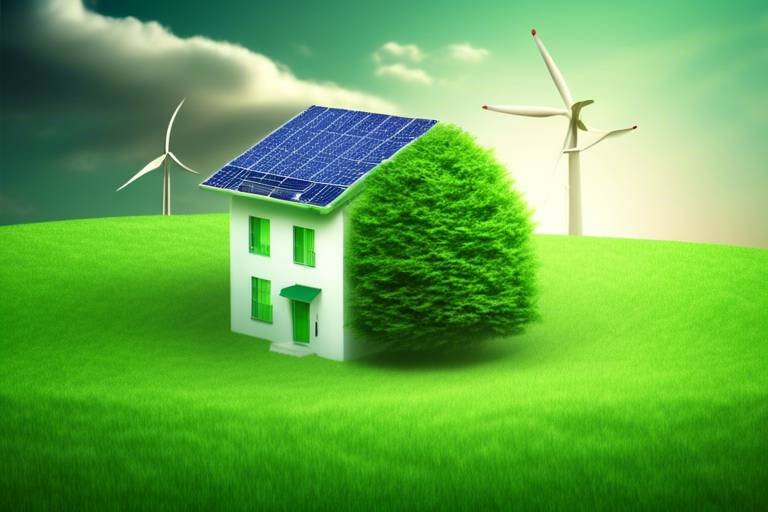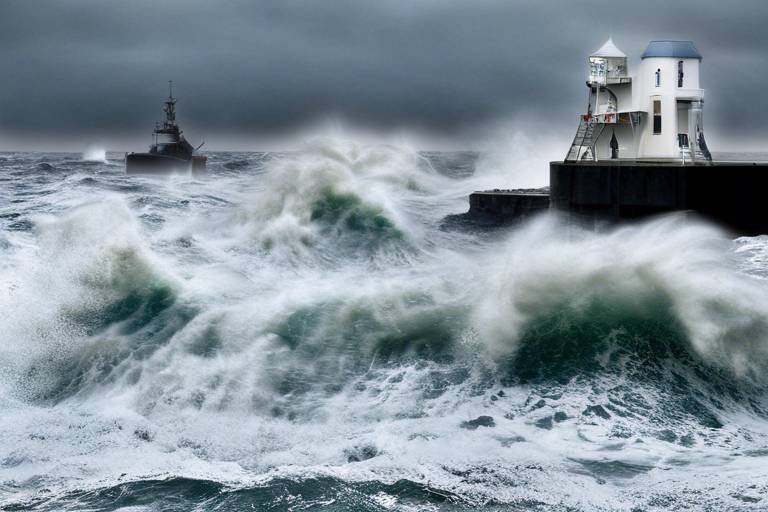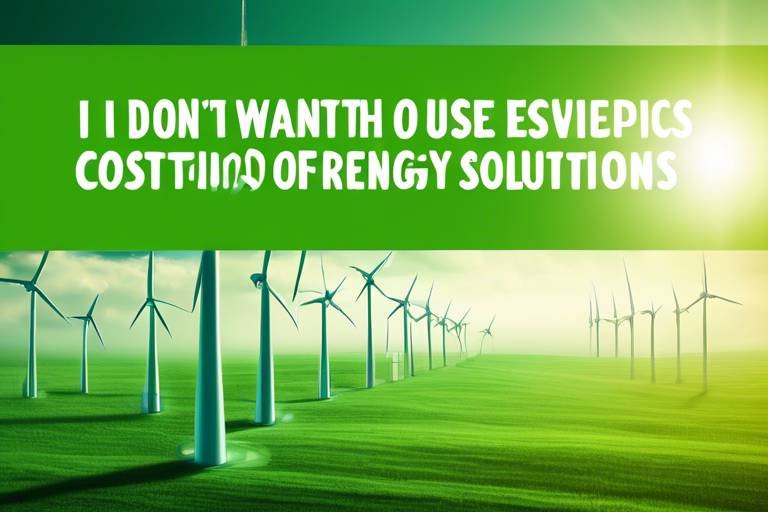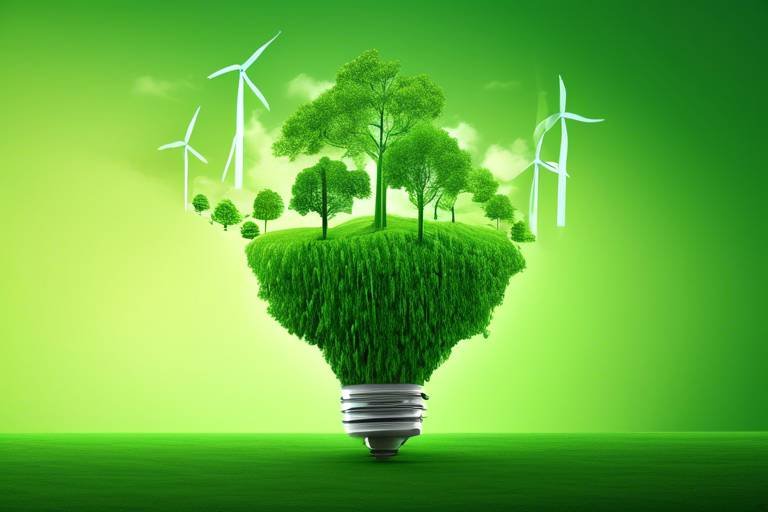List of World's Top Green Energy Producers
As the world grapples with the pressing challenges of climate change and environmental degradation, the shift towards renewable energy has become more crucial than ever. This article explores the leading green energy producers globally, highlighting their contributions, technologies, and impact on sustainability. Discover how these companies are shaping the future of renewable energy.
In recent years, the demand for clean energy solutions has surged, prompting a remarkable transformation in the energy sector. Companies specializing in green energy have not only embraced innovative technologies but have also committed to reducing their carbon footprints. By harnessing the power of the sun, wind, and water, these organizations are paving the way for a sustainable future.
So, who are the titans of green energy? Let's dive into the world of solar, wind, and hydropower producers that are making a significant impact. Each of these companies is a beacon of hope, demonstrating that it's possible to generate energy without harming our planet. The following sections will provide a closer look at these industry leaders, their groundbreaking technologies, and their contributions to a greener tomorrow.
Solar energy has become one of the fastest-growing sources of renewable energy worldwide. Leading the charge are companies like First Solar, SunPower, and Canadian Solar. These firms have invested heavily in research and development, resulting in innovative solar panel technologies that maximize efficiency and reduce costs.
For instance, First Solar is renowned for its thin-film solar technology, which offers a lightweight and flexible alternative to traditional panels. This innovation not only enhances energy output but also makes solar installations more accessible in various environments. Similarly, SunPower's high-efficiency solar panels set industry standards, proving that harnessing the sun's energy can be both effective and sustainable.
Wind energy is another significant player in the renewable sector, with companies like Vestas, Siemens Gamesa, and GE Renewable Energy leading the way. These giants have developed extensive wind farm projects across the globe, contributing to a cleaner energy mix and reducing dependence on fossil fuels.
Offshore wind energy is gaining momentum, with advancements in technology allowing for larger and more efficient turbines. Companies such as Ørsted and Equinor are at the forefront of this revolution, operating some of the largest offshore wind farms in the world. These projects not only generate substantial amounts of electricity but also create jobs and stimulate local economies.
One of the most exciting developments in offshore wind energy is the advent of floating wind turbines. These innovative structures can be deployed in deeper waters, where wind speeds are higher and more consistent. This technology is set to revolutionize the industry, significantly increasing the potential for clean energy generation.
While offshore wind farms offer numerous benefits, they also pose challenges to marine ecosystems. It's essential to assess their environmental impact carefully. Strategies such as thorough environmental assessments and adaptive management practices can help minimize disruption to marine life, ensuring that the transition to renewable energy is sustainable.
Onshore wind energy projects are equally vital, with numerous initiatives across various regions. Companies like NextEra Energy and EDP Renewables are making significant strides in this area. By investing in local communities and infrastructure, these companies are not only providing clean energy but also promoting energy independence.
Hydropower remains one of the most reliable sources of renewable energy, with giants like China Yangtze Power and Brookfield Renewable Partners leading the charge. These companies operate large-scale hydropower plants that harness the energy of flowing water to generate electricity sustainably.
The world’s largest hydropower plants, such as the Three Gorges Dam in China, showcase the potential of this renewable resource. With a capacity of over 22,500 megawatts, it plays a crucial role in providing reliable energy to millions while addressing environmental concerns through careful management of water resources.
On the other hand, small-scale hydropower systems are gaining traction in rural communities, offering localized energy solutions. These systems can be less intrusive and more sustainable, providing energy independence to smaller populations while promoting environmental stewardship.
- What is green energy? Green energy refers to energy generated from renewable resources that have minimal environmental impact, such as solar, wind, and hydropower.
- How do solar panels work? Solar panels convert sunlight into electricity through photovoltaic cells, which generate direct current (DC) electricity that can be converted to alternating current (AC) for use in homes and businesses.
- What are the benefits of wind energy? Wind energy is clean, abundant, and sustainable, reducing greenhouse gas emissions and dependence on fossil fuels while creating jobs in the renewable energy sector.
- Are hydropower plants harmful to the environment? While hydropower is a renewable resource, it can impact local ecosystems. However, careful planning and management can mitigate these effects.

Global Leaders in Solar Energy
When it comes to solar energy, the world is witnessing a remarkable transformation, with several companies taking the lead in harnessing the sun's power. These global leaders in solar energy not only contribute significantly to the renewable energy landscape but also play a crucial role in combating climate change. With their innovative technologies and sustainable practices, they are paving the way for a greener future.
One of the most notable players in the solar energy sector is First Solar. This American company has made a name for itself by producing thin-film solar panels that are both efficient and less resource-intensive compared to traditional silicon-based panels. Their commitment to sustainability is evident in their manufacturing process, which utilizes a closed-loop system to recycle materials. First Solar's projects span across various continents, making them a key contributor to the global solar market.
Another giant in the industry is SunPower Corporation, renowned for its high-efficiency solar panels. With an impressive market share, SunPower has established itself as a leader in providing solar solutions for both residential and commercial sectors. Their panels boast an efficiency rate of over 22%, which means they convert more sunlight into electricity than most competitors. This technological edge not only maximizes energy output but also offers customers greater savings on their energy bills.
China has also emerged as a powerhouse in solar energy production, with companies like Trina Solar and JA Solar leading the charge. These companies have invested heavily in research and development, resulting in cutting-edge solar technologies that are setting new standards in the industry. For instance, Trina Solar has recently unveiled their Vertex series of solar modules, which are designed to deliver higher power output while maintaining a competitive cost. This innovation is crucial for expanding solar energy adoption globally.
Moreover, Canadian Solar has made significant strides in the solar market by focusing on both solar module manufacturing and project development. Their commitment to sustainability extends beyond just producing solar panels; they actively engage in community development and environmental stewardship. Canadian Solar's global reach means that they are not only impacting their home country but also contributing to solar energy projects in emerging markets, thus promoting energy independence.
As we look towards the future, it's clear that these leaders in solar energy are not just driving the industry forward; they are also inspiring a global movement towards sustainability. The advancements in solar technology and the commitment to reducing carbon footprints are essential in the fight against climate change. By investing in renewable energy sources, these companies are not only enhancing their own business models but also contributing to a more sustainable planet.
In conclusion, the global leaders in solar energy are reshaping the energy landscape with their innovative solutions and sustainable practices. As they continue to develop new technologies and expand their reach, the potential for solar energy to meet the world's energy demands grows exponentially. It's an exciting time for renewable energy, and these companies are at the forefront of this green revolution.
- What are the benefits of solar energy?
Solar energy is renewable, reduces electricity bills, and decreases greenhouse gas emissions, contributing to a cleaner environment. - How do solar panels work?
Solar panels convert sunlight into electricity using photovoltaic cells that generate direct current (DC) electricity, which is then converted to alternating current (AC) for use in homes and businesses. - What are the leading countries in solar energy production?
China, the United States, and Germany are among the top countries producing solar energy, with significant investments in solar infrastructure and technology.

Wind Energy Powerhouses
When we think about the future of energy, it's hard not to get excited about the that are leading the charge. These companies are not just generating electricity; they are transforming the way we think about energy sustainability. With their innovative technologies and expansive wind farm projects, they are making significant strides toward a greener planet. Have you ever stood on a hilltop and felt the rush of wind? Imagine that power harnessed to light up entire cities! It's incredible how these giants are tapping into nature's energy source.
At the forefront of this movement are some remarkable companies that have dedicated themselves to wind energy production. They are not just big players; they are the titans of the industry. For instance, Siemens Gamesa, a leader in the wind turbine market, has been pioneering advancements in turbine technology, making them more efficient and capable of generating power even in low-wind conditions. Another major player, Vestas, is renowned for its commitment to sustainability and innovation, boasting a significant market share and a global presence that spans over 80 countries.
These companies are contributing to a global transition to renewable energy sources in several ways:
- Investment in Technology: By investing heavily in research and development, these powerhouses are continuously improving turbine efficiency and performance.
- Expansion of Wind Farms: They are establishing vast wind farms both onshore and offshore, harnessing the wind's potential to generate massive amounts of electricity.
- Job Creation: As they expand, they create thousands of jobs, contributing to local economies and enhancing energy independence.
Wind energy is not just about the present; it’s about the future. The advancements in turbine technology have led to larger, more efficient models that can capture more wind energy. For example, the latest turbines can generate power at lower wind speeds, which means they can operate effectively in a wider range of conditions. This is crucial for maximizing output and ensuring a stable energy supply.
Moreover, the global investment in wind energy has skyrocketed in recent years. According to the latest reports, investments in wind energy reached an astounding $100 billion in 2022 alone. This surge in funding is a testament to the growing recognition of wind energy as a viable and essential component of the global energy mix. It's not just about reducing carbon footprints; it's also about creating a sustainable energy future for generations to come.
As we look ahead, the future of wind energy seems bright. With advancements in technology and increasing investments, these wind energy powerhouses are set to play a crucial role in the global transition to renewable energy. They are not just producing energy; they are shaping a sustainable future, proving that clean energy is not just a dream—it’s a reality that we can achieve together.
- What are wind energy powerhouses? Wind energy powerhouses are companies that lead in the production and innovation of wind energy technologies and projects.
- How do wind turbines work? Wind turbines convert the kinetic energy of wind into mechanical power, which is then converted into electricity.
- What is the environmental impact of wind energy? Wind energy has a low environmental impact compared to fossil fuels, as it produces no emissions during operation.
- Are wind farms noisy? While wind farms can produce noise, modern turbines are designed to operate more quietly than older models.

Offshore Wind Developments
As we sail into the future of renewable energy, are making waves like never before. With the ability to harness the powerful winds over the ocean, these projects are not just a breeze—they're a game-changer in the fight against climate change. Countries around the globe are investing heavily in offshore wind farms, recognizing their potential to deliver clean, sustainable energy while reducing reliance on fossil fuels.
Leading the charge are companies like Ørsted, Siemens Gamesa, and Vestas, who are pushing the boundaries of technology and innovation. These giants are not just constructing wind turbines; they are engineering floating platforms that can be deployed in deeper waters, where winds are stronger and more consistent. This advancement allows for larger turbines that can generate significantly more power than their onshore counterparts. For instance, the Hornsea Project in the UK is set to become the largest offshore wind farm in the world, with a capacity of over 2.5 gigawatts, enough to power more than a million homes.
But what exactly makes offshore wind energy so appealing? First and foremost, the efficiency of offshore wind farms is remarkable. The winds at sea are typically stronger and more reliable than those on land, which translates to higher energy output. Additionally, offshore wind farms can be built at a larger scale, allowing for the generation of substantial amounts of energy without the same level of land use conflicts that onshore projects often face.
However, the journey to harnessing offshore wind energy isn't without its challenges. The cost of developing these farms can be steep, involving complex logistics and advanced engineering. Yet, ongoing technological innovations are driving down these costs. For example, advancements in turbine design and installation techniques are making it easier and more affordable to build and maintain offshore wind farms. The use of drones for inspections and the development of larger, more efficient turbines are just a couple of examples of how the industry is evolving.
Furthermore, there's a growing recognition of the environmental impact of these projects. While offshore wind farms are a cleaner alternative to fossil fuels, they can still affect marine ecosystems. Companies are now focusing on minimizing this impact through careful site selection, monitoring, and employing technologies designed to protect marine life. The goal is to strike a balance between harnessing wind energy and preserving the delicate ocean environment.
In conclusion, offshore wind developments are not just a passing trend; they are a crucial pillar in the transition to a sustainable energy future. As technology continues to advance and costs decrease, we can expect these projects to proliferate, paving the way for a cleaner, greener world. The energy generated from these offshore wind farms will play a significant role in reducing greenhouse gas emissions and combating climate change, proving that the winds of change are indeed blowing in the right direction.
- What are offshore wind farms? Offshore wind farms are installations located in bodies of water that use wind turbines to generate electricity.
- How do offshore wind farms benefit the environment? They produce clean energy, reducing reliance on fossil fuels and lowering greenhouse gas emissions.
- What challenges do offshore wind developments face? High costs, logistical complexities, and potential impacts on marine ecosystems are significant challenges.
- Who are the leading companies in offshore wind energy? Ørsted, Siemens Gamesa, and Vestas are among the top players in the offshore wind sector.

Technological Innovations in Offshore Wind
The world of offshore wind energy is undergoing a revolution thanks to groundbreaking technological innovations that are making this renewable resource more efficient and accessible. Imagine harnessing the power of the ocean's winds to generate clean energy, and you'll begin to understand the potential that offshore wind holds. With advancements in turbine design, installation techniques, and energy storage, the future of offshore wind energy is not just promising; it's exciting!
One of the most significant innovations in offshore wind technology is the development of larger and more efficient turbines. Today's offshore wind turbines are marvels of engineering, with some reaching heights of over 200 meters and rotor diameters exceeding 150 meters. These giants can generate over 10 megawatts (MW) of power each, which is enough to supply thousands of homes with electricity. By increasing the size of the turbines, companies can capture more wind energy, thus maximizing output and reducing the cost per megawatt-hour.
Another critical advancement is the use of floating wind farms. Traditional offshore wind farms are anchored to the seabed, which can limit their placement to shallower waters. Floating wind technology allows turbines to be placed in deeper waters, where winds are typically stronger and more consistent. This innovation opens up vast new areas for wind energy production, significantly expanding the potential for offshore wind farms worldwide.
Moreover, the integration of smart grid technology is transforming how offshore wind energy is managed and distributed. By utilizing advanced data analytics and artificial intelligence, energy producers can optimize the performance of wind farms in real-time. This means that energy output can be adjusted based on demand, weather conditions, and other factors, leading to a more stable and reliable energy supply. Think of it as having a personal assistant for your energy needs, ensuring that everything runs smoothly and efficiently!
In terms of installation, innovations in installation vessels are making it easier and faster to deploy wind farms. These specialized ships are equipped with advanced cranes and dynamic positioning systems that allow them to install turbines in challenging offshore conditions. This not only reduces the time and cost associated with installation but also minimizes the environmental impact during the construction phase.
As we look to the future, the integration of energy storage solutions will play a crucial role in maximizing the benefits of offshore wind energy. By pairing wind farms with battery storage systems, excess energy generated during peak wind conditions can be stored and used during periods of low wind. This synergy between generation and storage is essential for creating a reliable and resilient energy grid.
In summary, the technological innovations in offshore wind energy are paving the way for a cleaner, more sustainable future. With larger turbines, floating wind farms, smart grid integration, advanced installation techniques, and energy storage solutions, the potential of offshore wind is just beginning to be realized. As these technologies continue to evolve, we can expect to see a significant increase in the contribution of offshore wind energy to the global energy mix, helping to combat climate change and promote sustainability.
- What are floating wind farms? Floating wind farms are offshore wind turbines that are not anchored to the seabed but are instead mounted on floating platforms, allowing them to be placed in deeper waters.
- How do larger turbines improve efficiency? Larger turbines can capture more wind energy due to their increased rotor size and height, leading to greater energy output and lower costs per megawatt-hour.
- What is the role of energy storage in offshore wind? Energy storage systems allow excess energy generated during peak production to be stored and used during low production periods, ensuring a stable energy supply.

Environmental Impact of Offshore Wind Farms
Offshore wind farms are often hailed as a beacon of hope for sustainable energy, but like any major development, they come with their own set of environmental impacts. Understanding these impacts is crucial as we strive to balance energy needs with ecological preservation. One of the primary concerns is the effect on marine life. The construction and operation of wind turbines can disrupt local ecosystems, potentially leading to displacement of fish and other marine organisms. For instance, the noise generated during the installation phase can interfere with the communication and navigation of marine species, particularly those that rely on echolocation.
Moreover, the presence of large structures in the ocean can alter currents and sediment patterns, which may have cascading effects on local habitats. It’s essential to conduct thorough environmental assessments before the development of offshore wind farms to identify potential risks and mitigate them effectively. This includes evaluating the impact on migratory bird patterns, as turbines can pose collision risks for birds flying in the area. However, advancements in technology and design are helping to minimize these risks. For example, some companies are now using bird detection systems that can temporarily shut down turbines when flocks are detected nearby.
On a more positive note, offshore wind farms can also contribute to environmental benefits. By generating clean energy, they help reduce reliance on fossil fuels, leading to lower greenhouse gas emissions. This transition is vital in combating climate change, which poses its own set of threats to marine and terrestrial ecosystems. Additionally, the artificial reefs created by the foundations of wind turbines can provide new habitats for marine life, promoting biodiversity in areas that may have been previously barren.
To better understand the environmental impact, let’s take a look at the following table that summarizes key factors:
| Impact Type | Positive Effects | Negative Effects |
|---|---|---|
| Marine Ecosystems | Potential for new habitats | Disruption of local species |
| Bird Migration | None | Collision risks |
| Climate Change | Reduction in greenhouse gases | None |
| Noise Pollution | None | Impact on marine communication |
As we move forward, it’s imperative for developers to adopt best practices and innovative solutions to minimize ecological disruption. This includes conducting extensive research during the planning phase, engaging with environmental scientists, and implementing adaptive management strategies that allow for ongoing monitoring of environmental impacts. The goal is to ensure that while we harness the power of wind, we also protect the delicate balance of marine ecosystems.
- What are the main environmental concerns associated with offshore wind farms? The primary concerns include disruption to marine life, noise pollution affecting echolocation, and the potential for bird collisions.
- How do offshore wind farms benefit the environment? They provide clean energy that reduces reliance on fossil fuels, helping combat climate change and can create artificial reefs that promote marine biodiversity.
- What measures can be taken to mitigate the environmental impact? Conducting thorough environmental assessments, utilizing bird detection systems, and implementing adaptive management strategies can help minimize negative effects.

Onshore Wind Projects
Onshore wind energy has emerged as a powerhouse in the global push towards renewable energy. With vast landscapes and open fields, countries around the world are harnessing the power of wind to generate clean electricity. These projects not only contribute to reducing carbon emissions but also foster local economies and promote energy independence. The sheer scale of onshore wind farms can be breathtaking, with towering turbines standing tall against the horizon, capturing the invisible force of the wind and converting it into usable energy.
One of the most impressive aspects of onshore wind projects is the innovation driving their development. Companies are constantly pushing the boundaries of technology to improve efficiency and output. For instance, advancements in turbine design have led to larger blades and higher towers, allowing for greater energy capture even in areas with lower wind speeds. The integration of smart technology, such as sensors and data analytics, helps optimize performance and maintenance schedules, ensuring that these turbines operate at peak efficiency.
Let's take a closer look at some significant onshore wind projects that are making waves in the renewable energy sector:
| Project Name | Location | Capacity (MW) | Year Commissioned |
|---|---|---|---|
| Gansu Wind Farm | China | 7,965 | 2010 |
| Alta Wind Energy Center | California, USA | 1,550 | 2010 |
| London Array | UK | 630 | 2013 |
| Shepherds Flat Wind Farm | Oregon, USA | 845 | 2012 |
These projects are not just numbers; they represent a significant shift in how we generate energy. For example, the Gansu Wind Farm in China is one of the largest in the world, showcasing the country's commitment to renewable energy. Similarly, the Alta Wind Energy Center in California has become a vital source of clean energy for the state, proving that onshore wind can play a crucial role in meeting energy demands.
Moreover, onshore wind projects often lead to job creation, both during the construction phase and in ongoing operations and maintenance. Local communities benefit from the influx of jobs and investment, which can stimulate economic growth. This is particularly relevant in rural areas where traditional industries may be declining. By embracing wind energy, these communities not only gain a sustainable energy source but also a revitalized economy.
However, it's essential to address some challenges that come with onshore wind projects. The need for suitable land, potential impacts on wildlife, and community acceptance are all factors that developers must consider. Engaging with local stakeholders and ensuring that projects are designed with environmental considerations in mind can help mitigate these challenges. In many cases, community involvement can lead to greater support for wind energy initiatives, as people see the tangible benefits they bring.
In conclusion, onshore wind projects are a critical component of the renewable energy landscape. They offer a sustainable solution to our energy needs while providing economic benefits to local communities. As technology continues to evolve and more projects come online, the future of onshore wind energy looks incredibly promising.
- What are onshore wind projects? Onshore wind projects involve the installation of wind turbines on land to generate electricity from wind energy.
- How do onshore wind farms contribute to the economy? They create jobs, stimulate local economies, and can provide additional tax revenue for communities.
- Are there any environmental concerns with onshore wind projects? Yes, potential impacts on wildlife and land use must be considered, but with proper planning, these can be mitigated.
- What is the future of onshore wind energy? The future looks bright as technology advances and more countries invest in renewable energy sources.

Hydropower Giants
When we talk about renewable energy, hydropower often stands out as one of the most reliable and established sources. Hydropower giants play a crucial role in harnessing the energy of flowing water to generate electricity. These companies not only contribute significantly to the global energy supply but also pave the way for sustainable development. With the ability to produce massive amounts of energy, hydropower plants are among the largest electricity producers in the world. But what exactly makes these giants so important? Let’s dive into their major projects and the innovative technologies they employ.
Leading the charge in hydropower are companies like China Three Gorges Corporation, Électricité de France (EDF), and Hydro-Québec. These organizations have built some of the largest hydropower plants that harness the power of rivers and lakes. For instance, the Three Gorges Dam in China is not just a marvel of engineering; it is the largest power station in the world in terms of installed capacity, with a staggering 22,500 megawatts. This single facility alone is capable of generating enough electricity to power millions of homes, showcasing the immense potential of hydropower.
But it’s not just about the size of these projects; it’s also about their impact. Hydropower plants can provide a steady and reliable source of energy, which is crucial for stabilizing power grids. Unlike solar and wind energy, which can be intermittent, hydropower can be adjusted to meet demand. This flexibility makes it an essential player in the transition to renewable energy. For example, during peak demand times, hydropower plants can ramp up production quickly, ensuring that there’s always enough electricity available.
Let’s take a closer look at some of the key players in the hydropower sector and their major projects:
| Company | Major Project | Installed Capacity (MW) | Location |
|---|---|---|---|
| China Three Gorges Corporation | Three Gorges Dam | 22,500 | China |
| Électricité de France (EDF) | La Grande Énergie | 15,000 | Canada |
| Hydro-Québec | Manic-5 | 1,500 | Canada |
While large-scale hydropower projects dominate the landscape, small-scale hydropower solutions are gaining traction, particularly in rural areas. These systems are designed to provide localized energy solutions that can significantly enhance energy access while promoting sustainability. For example, micro-hydropower plants can be installed in remote communities, harnessing the energy of small streams to generate electricity for local use. This not only reduces dependence on fossil fuels but also empowers communities by providing them with a sustainable energy source.
However, the development of hydropower is not without challenges. Environmental concerns, such as the impact on aquatic ecosystems and local communities, must be carefully managed. Companies are increasingly adopting strategies to minimize these effects, such as implementing fish ladders and conducting thorough environmental assessments before project initiation. By doing so, hydropower giants are working towards a more sustainable future, balancing energy production with ecological preservation.
In summary, hydropower giants are crucial players in the global shift towards renewable energy. Their ability to generate massive amounts of electricity from flowing water not only supports energy demands but also contributes to sustainability efforts worldwide. As we continue to seek solutions for climate change, the innovations and projects spearheaded by these companies will undoubtedly play a pivotal role in shaping our energy future.
- What is hydropower? Hydropower is a form of renewable energy that uses the flow of water to generate electricity.
- How do hydropower plants work? They capture the kinetic energy of flowing water, converting it into mechanical energy, which is then transformed into electrical energy.
- What are the environmental impacts of hydropower? While hydropower is cleaner than fossil fuels, it can affect aquatic ecosystems, so careful planning is essential.
- Are small-scale hydropower systems effective? Yes, they can provide localized energy solutions and reduce reliance on larger, centralized power grids.

Large-Scale Hydropower Plants
When we think about renewable energy, often come to mind as colossal structures that harness the might of flowing water. These engineering marvels not only generate a significant portion of the world's electricity but also play a crucial role in stabilizing energy grids. Imagine a giant river, its waters rushing past, and a dam built to capture that energy. This is the essence of hydropower. The sheer size and capacity of these plants make them vital contributors to our energy landscape.
Across the globe, large-scale hydropower plants are responsible for powering millions of homes and businesses. For instance, the Three Gorges Dam in China stands as the largest hydropower project in the world, boasting an installed capacity of over 22,500 megawatts! This incredible facility not only generates power but also plays a significant role in flood control and river navigation. The benefits of such plants are numerous, but they also come with their own set of challenges and environmental considerations.
Let's take a look at some of the most notable large-scale hydropower plants around the world:
| Hydropower Plant | Location | Capacity (MW) | Year Completed |
|---|---|---|---|
| Three Gorges Dam | China | 22,500 | 2012 |
| Itaipu Dam | Brazil/Paraguay | 14,000 | 1984 |
| Belo Monte Dam | Brazil | 11,233 | 2016 |
| Grand Coulee Dam | USA | 6,809 | 1942 |
These plants demonstrate the immense potential of hydropower. However, it's essential to recognize that their construction and operation can lead to significant ecological changes. When a dam is built, it alters the natural flow of rivers, affecting local wildlife and ecosystems. Fish populations can decline, and the surrounding areas may experience changes in land use and habitat. Therefore, while large-scale hydropower plants are a powerful source of renewable energy, they must be managed carefully to mitigate their environmental impact.
In addition to their capacity for generating energy, large-scale hydropower plants also contribute to economic development. They create jobs during construction and operation, provide a reliable source of electricity that can attract businesses, and support local communities. The revenue generated from these projects can lead to improved infrastructure, education, and healthcare in nearby areas, ultimately enhancing the quality of life for residents.
As we continue to seek sustainable energy solutions, large-scale hydropower plants remain a cornerstone of our approach to renewable energy. They exemplify how we can utilize natural resources to meet our energy needs while also addressing climate change. The balance between energy production and environmental stewardship is delicate, but with careful planning and innovative technology, we can harness the power of water to create a cleaner, more sustainable future.
- What are large-scale hydropower plants?
Large-scale hydropower plants are significant energy generation facilities that utilize the flow of water, typically through dams, to produce electricity on a massive scale. - How do they impact the environment?
While they provide renewable energy, large-scale hydropower plants can disrupt local ecosystems, affect fish populations, and alter land use. - What are some examples of large-scale hydropower plants?
Notable examples include the Three Gorges Dam in China, Itaipu Dam in Brazil/Paraguay, and Grand Coulee Dam in the USA. - Can hydropower plants contribute to local economies?
Yes, they create jobs, stimulate local businesses, and improve infrastructure, benefiting the communities around them.

Small-Scale Hydropower Solutions
When we think about hydropower, images of massive dams and sprawling reservoirs often come to mind. However, there's a quieter, yet equally impactful, player in the renewable energy scene: . These systems, typically defined as plants with a capacity of less than 10 megawatts, harness the energy of flowing water in a way that is not only efficient but also remarkably sustainable. Just imagine harnessing the natural flow of a river or stream to power your home or community—it's a game-changer!
One of the most compelling aspects of small-scale hydropower is its ability to provide localized energy solutions. Unlike large-scale projects, which can require extensive infrastructure and investment, small-scale systems are often easier to implement and can be tailored to meet the specific needs of a community. This localized approach not only enhances energy independence but also fosters community engagement and investment. Think about it: when a community can generate its own electricity, it empowers residents and reduces reliance on distant power grids.
In many rural areas, where access to the main electricity grid can be limited or non-existent, small-scale hydropower can be a lifeline. These systems can be installed in remote locations, making renewable energy accessible to communities that might otherwise be left in the dark. Moreover, they often have a lower environmental impact compared to their larger counterparts, as they can be designed to blend seamlessly into the surrounding ecosystem.
However, while the benefits are clear, small-scale hydropower solutions do come with their own set of challenges. For instance, the initial investment can still be significant, and the technology needs to be carefully selected to ensure it suits the specific water flow and environmental conditions of the site. Additionally, there are regulatory hurdles to navigate, as local governments may have specific guidelines regarding water usage and environmental protection.
To illustrate the potential of small-scale hydropower, consider the following table showcasing some successful implementations around the globe:
| Location | Capacity (MW) | Year Established | Community Impact |
|---|---|---|---|
| Wales, UK | 0.5 | 2015 | Provides power to 150 homes |
| California, USA | 2.0 | 2018 | Supports local agriculture |
| Himalayas, Nepal | 1.0 | 2012 | Improved energy access for remote villages |
As we look towards the future, the role of small-scale hydropower solutions in the global energy mix is becoming increasingly vital. With ongoing advancements in technology, such as the development of more efficient turbines and streamlined installation processes, the potential for these systems to contribute to sustainable energy goals is immense. They not only promise to reduce carbon footprints but also to enhance the resilience of local communities against energy shortages.
In conclusion, small-scale hydropower is more than just a renewable energy solution; it represents a shift towards a more sustainable and self-sufficient future. As communities around the world continue to embrace this technology, we can expect to see a significant impact on both local economies and the environment. So, why not consider how these small but mighty systems could transform your community?
- What is small-scale hydropower? Small-scale hydropower refers to hydropower systems with a capacity of less than 10 megawatts, designed to harness the energy of flowing water for local energy needs.
- What are the benefits of small-scale hydropower? Benefits include localized energy production, reduced environmental impact, and enhanced energy independence for communities.
- Are there any challenges associated with small-scale hydropower? Yes, challenges include initial investment costs, regulatory hurdles, and the need for site-specific technology.
- How does small-scale hydropower impact local communities? It provides reliable energy access, supports local economies, and fosters community engagement in energy production.
Frequently Asked Questions
- What are the main sources of green energy?
Green energy primarily comes from renewable sources such as solar, wind, hydropower, geothermal, and biomass. Each of these sources harnesses natural processes to generate electricity without depleting resources or harming the environment.
- How does solar energy work?
Solar energy is captured through solar panels that convert sunlight into electricity. These panels contain photovoltaic cells that absorb sunlight, creating a flow of electricity. This energy can be used directly, stored in batteries, or fed into the grid.
- What are the benefits of wind energy?
Wind energy is clean, abundant, and renewable. It reduces greenhouse gas emissions, creates jobs, and can provide energy independence. Plus, modern wind turbines have become more efficient, making wind energy a cost-effective solution for many regions.
- What is the difference between onshore and offshore wind energy?
Onshore wind energy is generated by wind turbines located on land, while offshore wind energy comes from turbines placed in bodies of water. Offshore wind farms generally have higher wind speeds and can produce more energy, but they also involve higher construction and maintenance costs.
- How does hydropower generate electricity?
Hydropower generates electricity by using the flow of water to turn turbines. When water is released from a dam or flows through a river, it spins the turbines, which then convert the kinetic energy into electrical energy.
- What are the environmental impacts of hydropower?
While hydropower is a clean energy source, it can disrupt local ecosystems, affect fish populations, and alter water quality. However, careful planning and modern technologies can help mitigate these impacts and promote sustainable practices.
- Can small-scale hydropower be viable?
Yes! Small-scale hydropower systems can provide localized energy solutions, especially in rural areas. They are less intrusive and can help communities achieve energy independence while promoting sustainability.
- What advancements are being made in offshore wind technology?
Recent advancements include larger turbine designs, floating turbine technology, and improved installation techniques. These innovations enhance efficiency and reduce costs, making offshore wind energy more viable and competitive.
- How can I support green energy initiatives?
You can support green energy by using renewable energy sources in your home, advocating for policies that promote sustainable practices, and supporting companies that prioritize green energy solutions. Every little effort counts!



